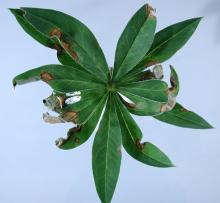Cause Many fungi have been reported causing leaf spots on species of lupine in the Pacific Northwest. These include Cercospora longispora, Hadrotrichum globiferum, Ramularia lupinicola (formerly Ovularia lupinicola), Plenodomus lupini (formerly Phoma lupini or Phyllosticta ferax), Placosphaeria lupini, Pseudocercospora lupini, Thedgonia lupini (sexual Mycosphaerella lupini {formerly Ramularia lupini}), Septoria lupinicola and the autoecious (can complete their life cycle on this one host) rust Uromyces lupini. Although not reported from the Pacific Northwest, the OSU Plant Clinic has diagnosed a few samples of anthracnose, Colletotrichum sp. Conditions that keep leaves wet for extended periods of time are favorable for disease development for most of these organisms.
Symptoms Ovularia is shown associated with light brown, necrotic spots that are irregular shaped and begin either on the leaf tips or margins.
Anthracnose is characterized with yellow spots forming on young leaves that develop into leaf blights. Stem cankers may also form and may be slightly contorted. Very susceptible plants wilt and dieback.
Thedgonia - Sub circular to irregular brown leaf spots that can defoliate in severe conditions. Yellowish sporodochia appear in the center of spots.
Cultural control
- Do not water from overhead, or adjust irrigation so plants are not wet for extended periods.
- Space plants for good air circulation.
- Remove and destroy infected plants and plant debris.
Chemical control
Ornamental materials:
- Broadform at 4 to 8 fl oz/100 gal water. Group 7 + 11 fungicide. 12-hr reentry.
- Disarm 480 SC at 1 to 4 fl oz/100 gal water. Group 11 fungicide. 12-hr reentry.
- Fame SC at 1 to 4 fl oz/100 gal water. Group 11 fungicide. 12-hr reentry.
- Although not specifically registered for lupine, products such as Heritage are safe on this crop, according to IR-4 data, and may be of some benefit. Group 11 fungicide. 4-hr reentry.
- Insignia at SC 3 to 6 fl oz/100 gal water. Do not use with organosilicate-based adjuvants. Use preventively only. Group 11 fungicide. 12-hr reentry.
- Ortho Rose & Flower Disease Control at 2 fl oz/gal water. Group 3 fungicide. H
Field Crop materials:
- Bravo Weather Stik at 1 to 1.5 pints/A. Do not apply within 14 days of harvest. 12-hr reentry.
- Headline at 6 to 9 fl oz/A. Preharvest interval is 21 days. 12-hr reentry.
Reference Kaiser, W.J., and Crous, P.W. 1998. Mycosphaerella lupini sp. nov., a serious leaf spot disease of perennial lupin in south-central Idaho, USA. Mycologia 90:726-731.



